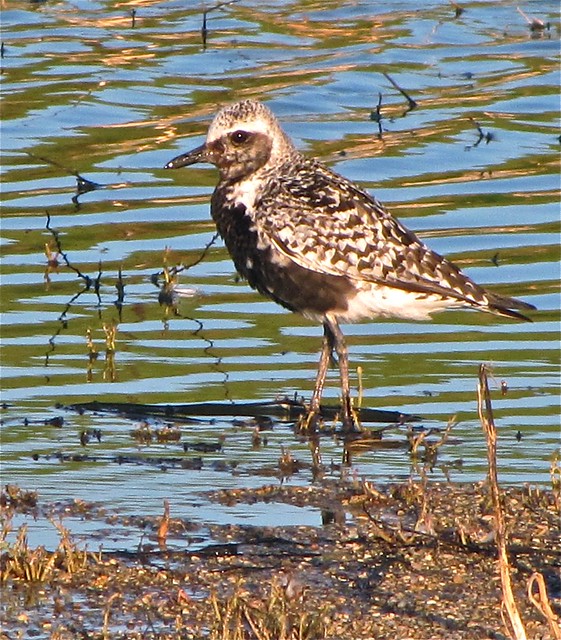
What is it about shorebirds that I enjoy so much? I like being able to look down and see a bird on the ground, or in water, or mud rather than getting a neck cramp while looking up to see them in the tops of trees. I enjoy the challenge of telling these birds apart. I am fascinated by the variety of species, the intricate patterns of their plumage, and their diverse body structures. Furthermore, I like being able to watch or photograph a bird or a group of birds for a long time without having to worry about them flying away the next second.
This Fall I was determined to add more shorebirds to my life list, but most of my birding is confined to McLean County, where I live. Unfortunately Evergreen Lake and Lake Bloomington, which often provide the best habitat for shorebirds in the county were at high levels, having little to no mudflats for most of the Fall. By the time we started to see some mudflat at Evergreen, it was too late for most of the shorebirds. By late Fall, Lake Bloomington was almost completely dried up. There was plenty of mudflat just in time for Dunlin, but I did not see any Dunlin in the whole county.
Since we had a hot, dry summer, there were also no flooded fields to attract shorebirds like there were in the Spring. This left me one option--sewage treatment plants. If you can get used to the smell, they can be great locations to bird. The water, rocks, grass, sand, and insects attract a variety of shorebirds and many other species, and none of the birds seem the least concerned about the sewage.
I began looking for Fall shorebirds at Gridley Wastewater Treatment Ponds in McLean County in mid-July and quickly found yellowlegs, Spotted, Solitary, and Least Sandpipers, and a Short-billed Dowitcher. I posted a blog about these early finds back in July at the following link.
http://murphbirder.blogspot.com/2011/07/short-billed-dowitcher-at-gridley.html
The other sewage treatment area I began to frequent was El Paso Sewage Treatment Center in Woodford County. The two sewage facilities are only a few miles apart, and both are close to where I work. This afforded me ample opportunity to bird at both locations. On July 11, I had Greater Yellowlegs, Spotted and Least Sandpipers at El Paso. Then on July 26, I saw found two Solitary Sandpipers at Gridley. One of them is shown below. Also present the same day were six Spotted Sandpipers and eleven Least Sandpipers.

The next day I captured this yellowlegs in flight at the same location.
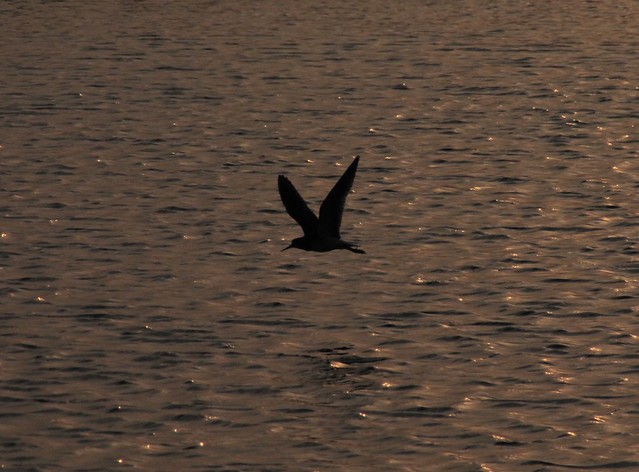
On July 29, I received word from Matthew Winks that Matt Fraker had found American Avocet at El Paso Sewage Treatment Center. Unfortunately, I had other obligations and could not go by until later. By the time I could get away, the avocets were gone, but I was able to see my first terns--Black Terns. There were at least twelve Black Terns skimming food off the surface of the water, while in flight. As you can see, their plumage varied. There were also chimney swifts and a variety of swallows feeding above the water. Although this blog is primarily about shorebirds, I will include some pictures of some of the other interesting birds that I saw at these two sewage treatment facilities.
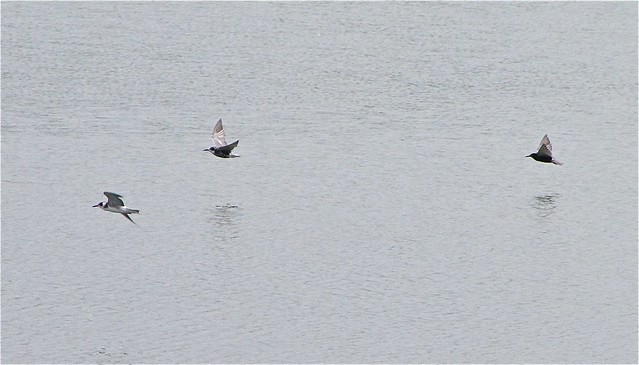

The next day, July 30, I returned to El Paso. The Black Terns had moved on, but I saw five of the six common swallow species--Barn, Bank, Cliff, Northern Rough-winged, and Tree Swallows. Either I missed Purple Martin, which Fraker had the previous day, or they were no longer present. Below are pictures of an adult Cliff Swallow, a juvenile Cliff Swallow, and two Bank Swallows.
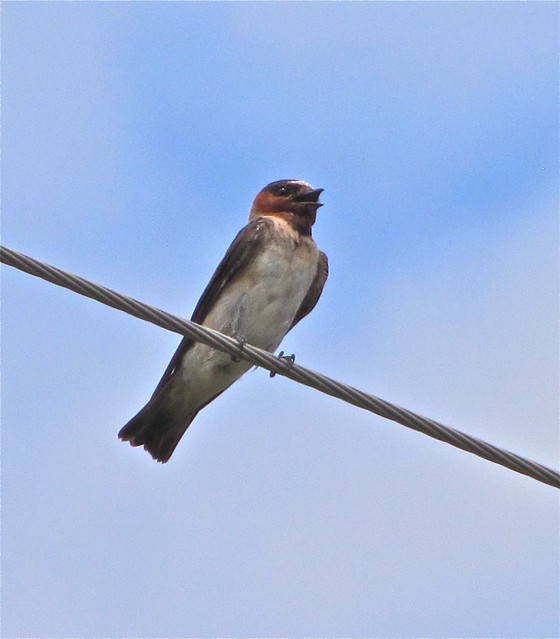


This shot provides a nice comparison between Cliff Swallow and Barn Swallow.

Among the shorebirds present was this beautiful Lesser Yellowlegs.

Several of the seven Spotted Sandpipers I saw were hatch year birds. Notice the absence of spotting on the chest.
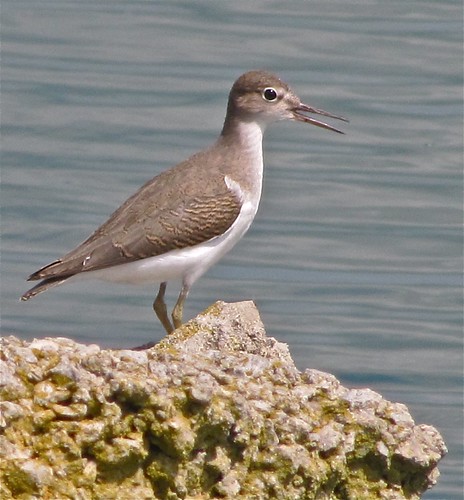
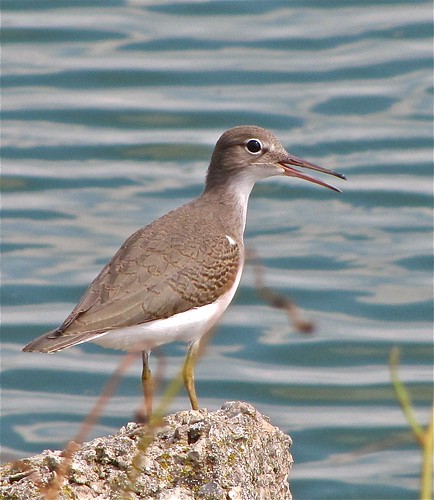
Compare the bird shown above with the adult bird shown below, which I photographed at Gridley on July 18.
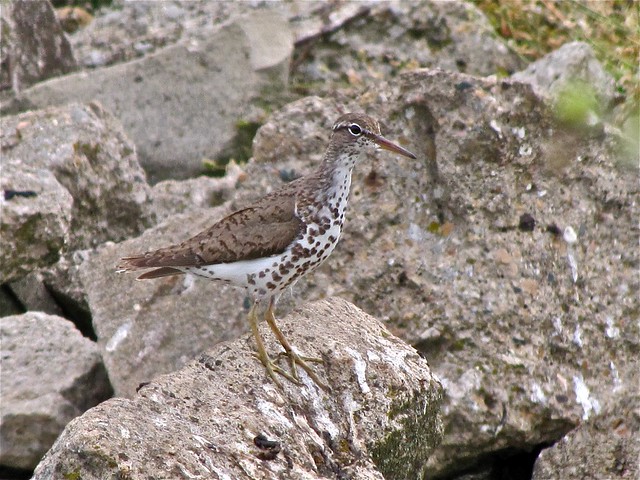
Also present at El Paso on July 30 were two Least Sandpipers and two Solitary Sandpipers. Notice the greenish legs on the Solitary below. I have learned that noticing the color of a shorebird's legs is important in identifying the species of the bird.
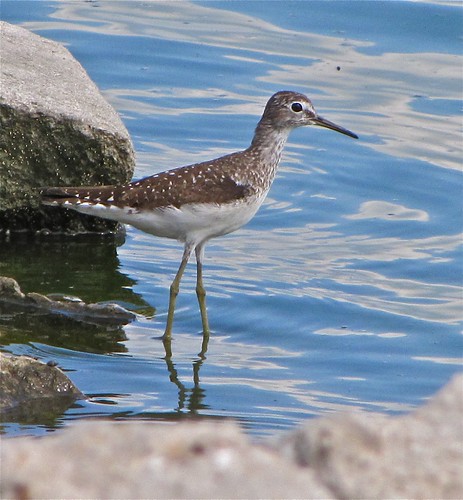
On August 6, I stopped by El Paso again and found this very lightly colored Pectoral Sandpiper. It was my first Pec of the season.
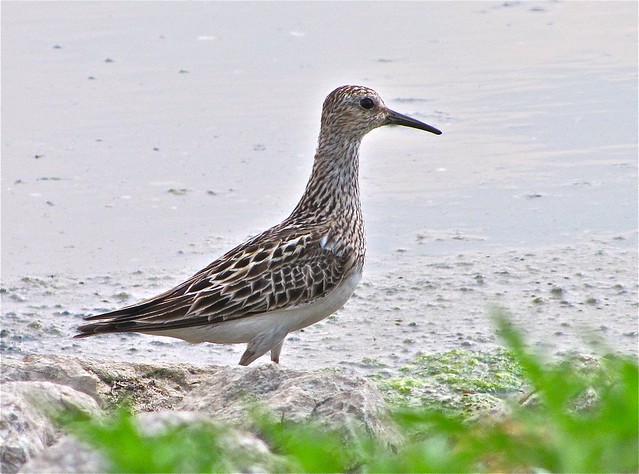
Then on August 8, I found this yellowlegs in nonbreeding plumage at the same location. I am not sure whether this bird is a Greater or Lesser Yellowlegs.

More Black Terns had stopped in at the El Paso facility on August 9, and I managed a shot of a Tree Swallow on a cable over the water.

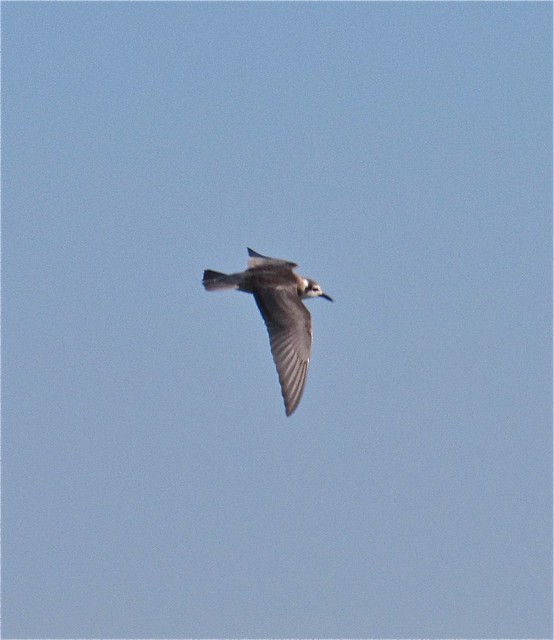

Also, among the Least Sandpipers present, this beautiful individual was hopping on one foot.
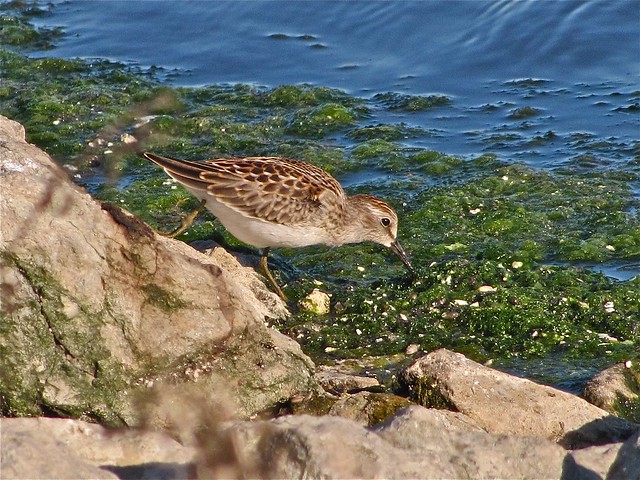


On August 15, I photographed this Least Sandpiper at Gridley.
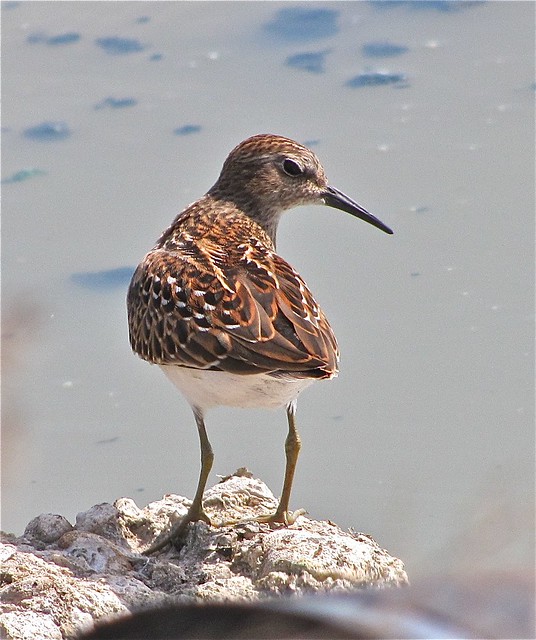
Although I rarely photograph them, Rock Pigeons are typically present at El Paso and occasionally present at Gridley. This individual was at El Paso on August 18.
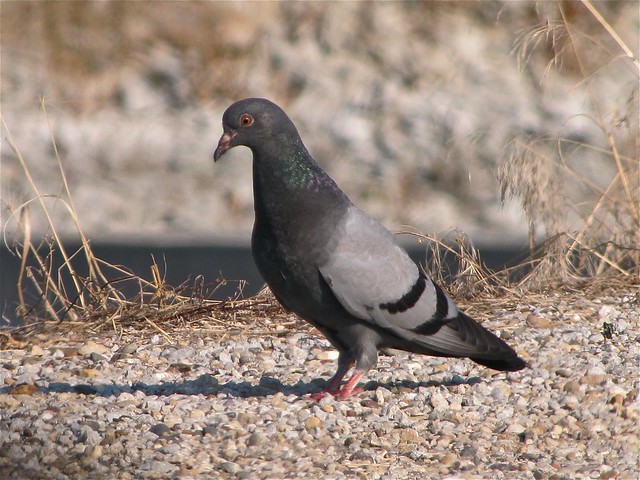
Also present at El Paso on August 18 were these two yellowlegs, this solitary sandpiper, and this least sandpiper all shown below.


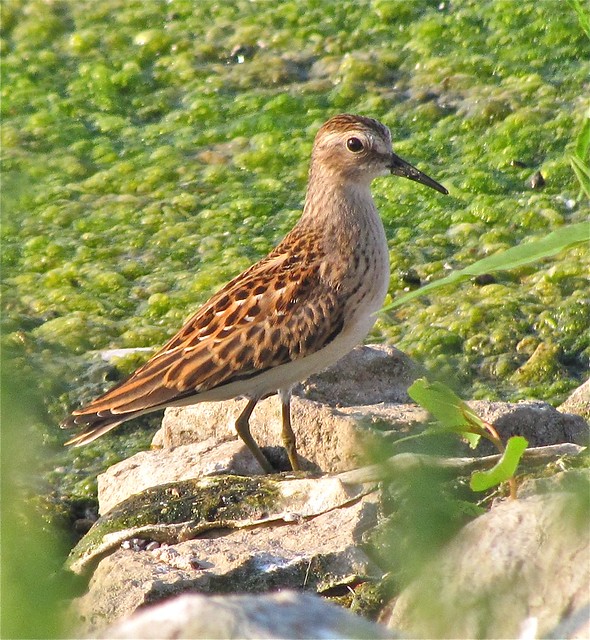
The same day on the rocks of the smaller pond on the Northeast corner of the facility, there was a bird feeding with two Least Sandpipers that seemed darker and slightly larger than the Least Sandpipers. It also appeared to have black legs rather than greenish legs, though there seemed to be some mud on the legs. Furthermore, its bill was straighter than the bills of the Leasts. It was a Semipalmated Sandpiper
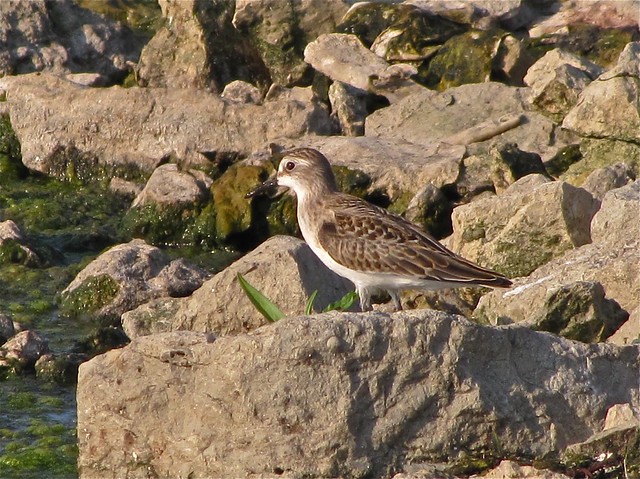


The next day, I returned to El Paso and found Tree and Cliff Swallows on the power lines near the entrance of the facility.
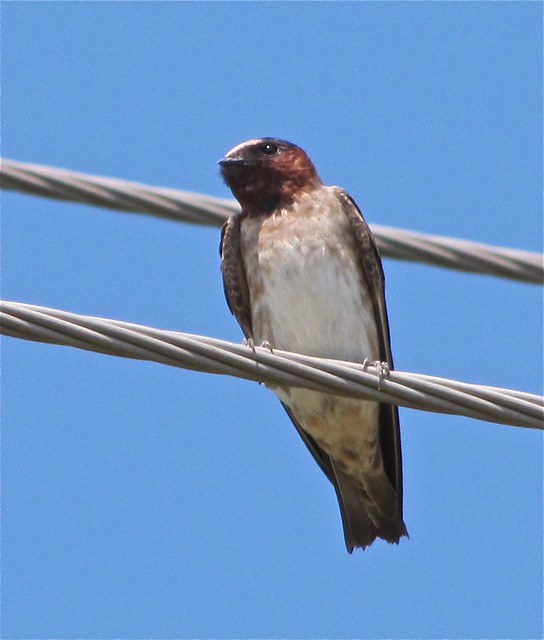
Among the shorebirds present at El Paso on August 19, was a Solitary Sandpiper. Then on the 22nd, I saw another Pectoral Sandpiper at the same location, and I photographed this Least Sandpiper on August 23.
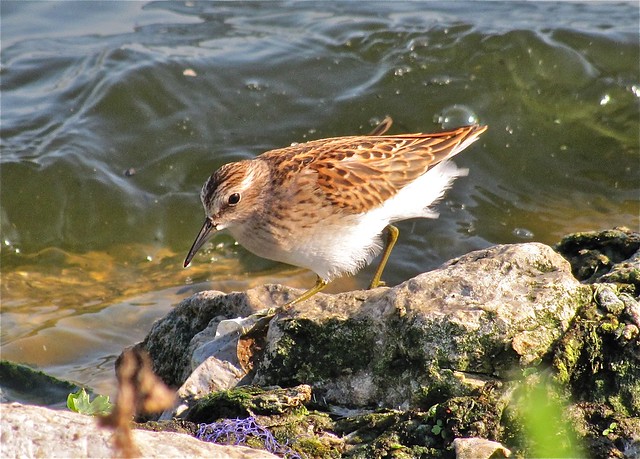
On August 27, I photographed this Killdeer in flight at Gridley.
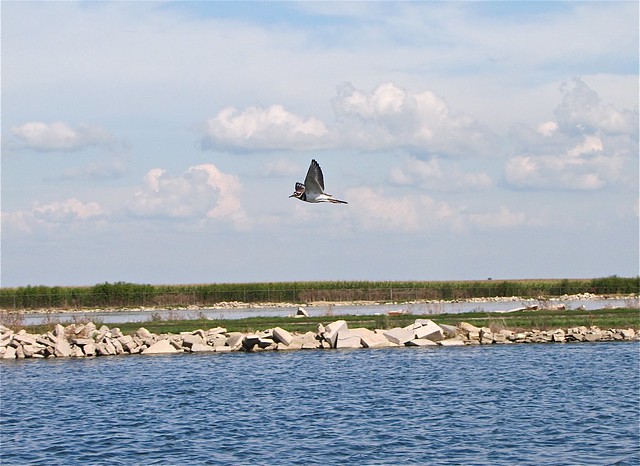
Although I have not yet said much about Killdeer in this post, they were always present in large numbers at both locations. I normally do not have the patience or desire to count Killdeer, but I usually either merely record their presence or make estimates of their numbers. Often the Killdeer would alert the other shorebirds to my presence. When the Killdeer would scream and fly away, the other shorebirds would usually fly away with them before I could get close enough to identify or photograph them. It seemed at times that the other shorebirds would position themselves near the killdeer so that they would be alerted of any potential danger by these skittish birds. Killdeer are beautiful birds, but they can often be annoying to me because of their noisy call and the fact that they often flush other birds before I can get a look at them.
Also present at Gridley on the 27th was this bird below, which I believed to be another Semipalmated Sandpiper, and a Least Sandpiper, shown below it. Notice the differences in bill shape, plumage, and leg color between the two.
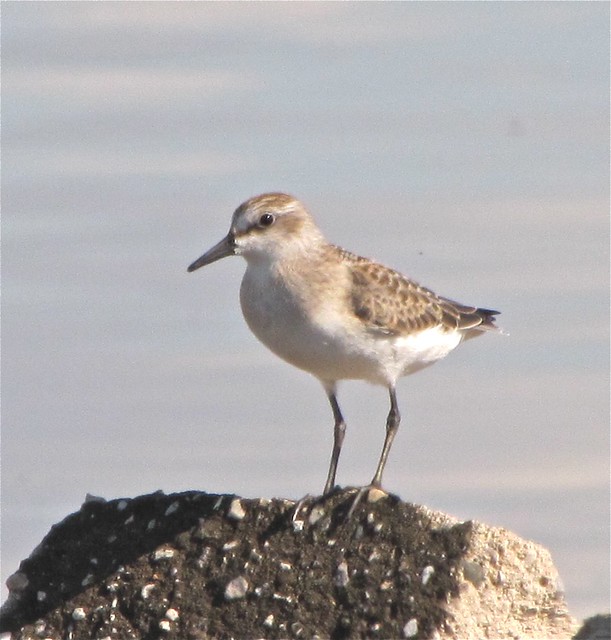
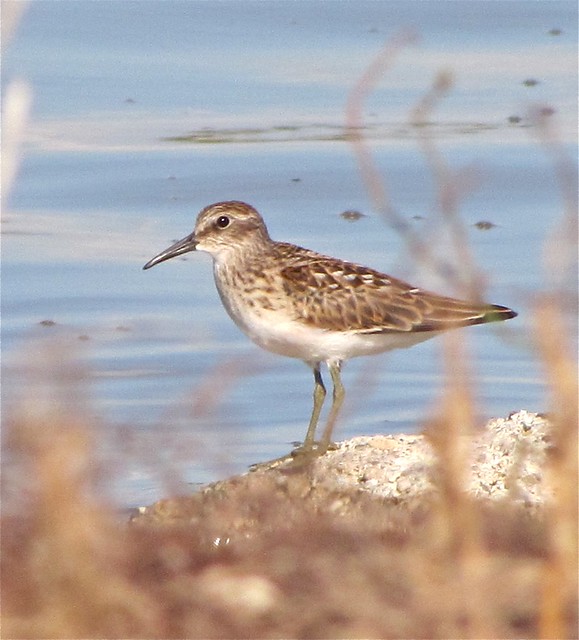
On August 28, I had a Lesser Yellowlegs, a Semipalmated Sandpiper, and five Least Sandpipers at Gridley. In addition to the species I reported above, there were also typically five or six Least Sandpipers at both locations every day that I checked during August.
While driving to El Paso from Gridley, on August 29, I stumbled upon this Red Fox hunting in the grass between Highway 24 and a corn field. I pulled off the road to take some pictures. To my surprise, the young fox walked right up to my car while it was hunting rodents. It seemed hardly aware of my presence, but there were a couple of instances that it looked directly at me while I was sitting in my car. Click on any of these photos directly below and scroll down to see more of this fox.
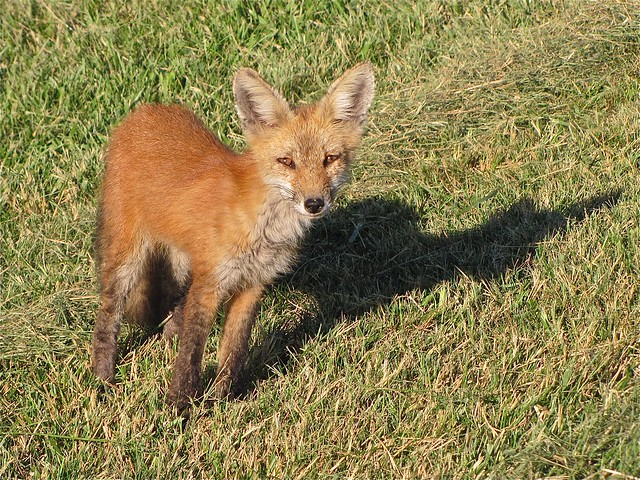

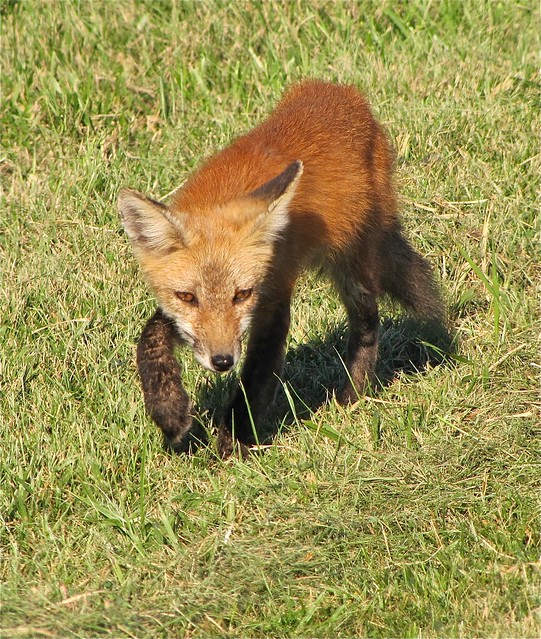
Click on the photo below and scroll down if you want to see the fox swallowing the mouse and the expression on its face after eating dinner.
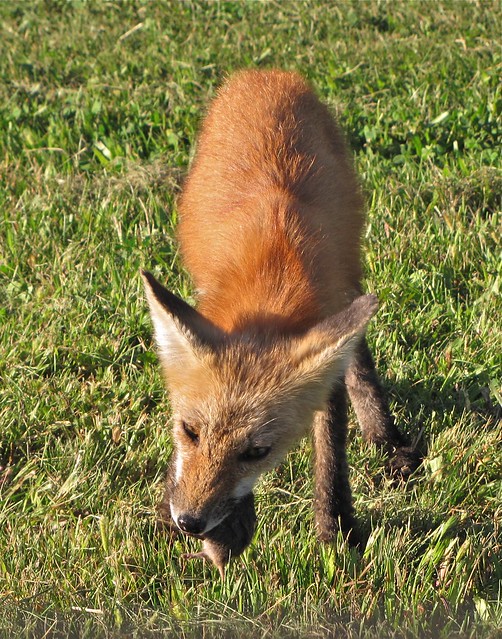
In this video, the fox is eating something else. I'm not sure what.
Though I spent a lot of time photographing the fox and the light was starting to fade, I continued to El Paso where I saw this Semipalmated Sandpiper.
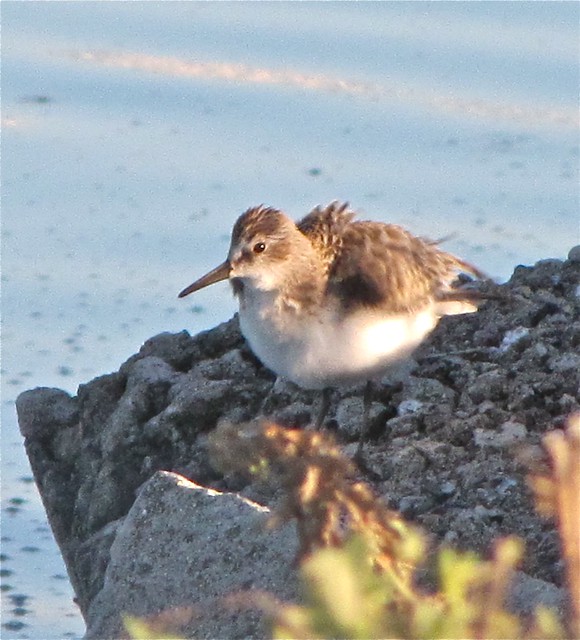
Also present were six Wood Ducks, Mallards, Killdeer, and a Great Blue Heron, but there seemed to be nothing new as far as shorebirds were concerned until I was about to leave the facility. On the edge of the South pond, I saw my lifer Sanderling. I later determined it was a hatch year bird based on the patterning on its back. I eventually was able to get into a position where I was between the bird and the light of the setting sun. Click on any of these pictures below and scroll down to see more of the Sanderling.

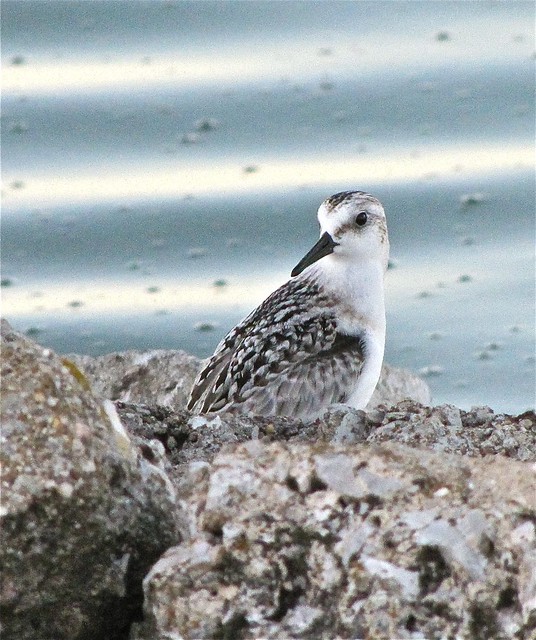
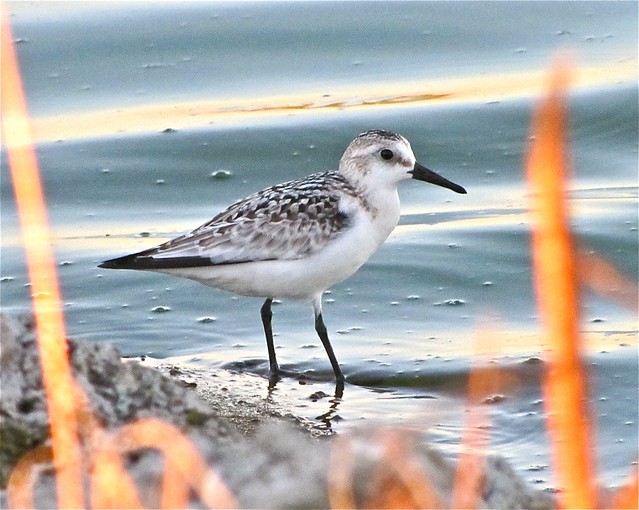
While photographing the Sanderling, I also noticed a second Semipalmated Sandpiper nearby.

The next day at Gridley, I saw four Buff-breasted Sandpipers. This species was also a lifer for me. I was able to drive up beside these birds while they were feeding in the grass around the ponds. Click on any of these pictures below and scroll down to see more of these Buff-breasted Sandpipers.
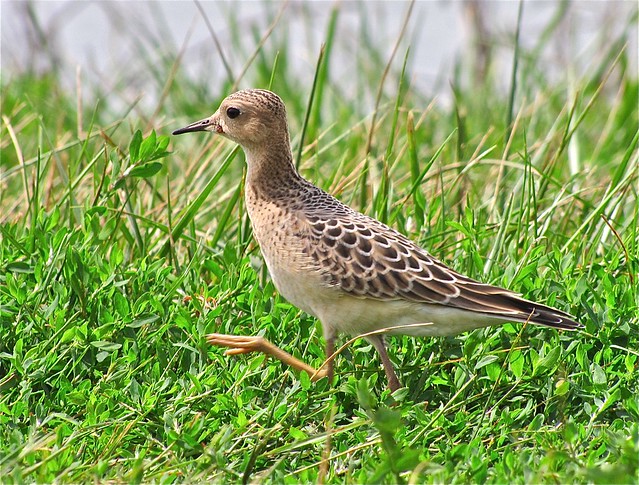
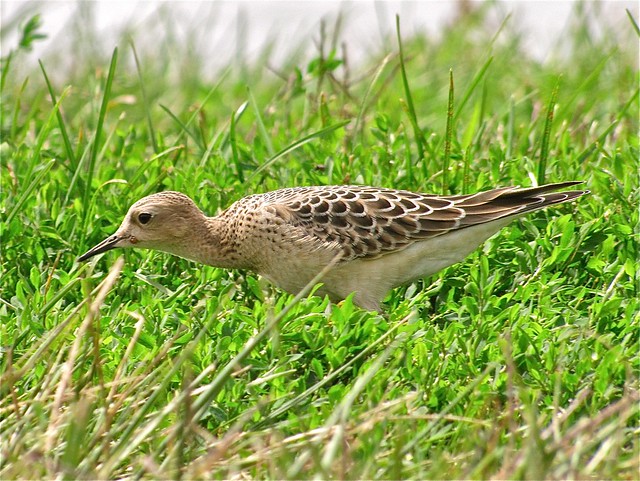
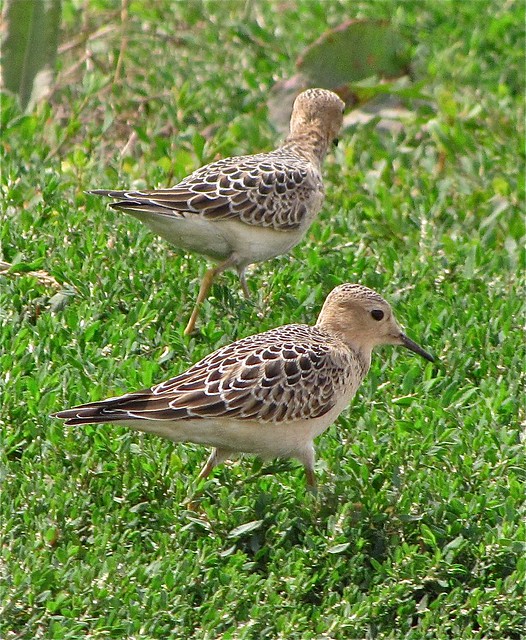
Also present at Gridley on August 30 was this Barn Swallow on the rocks by the pond and this Cooper's Hawk sitting on the fence at the edge of the facility.


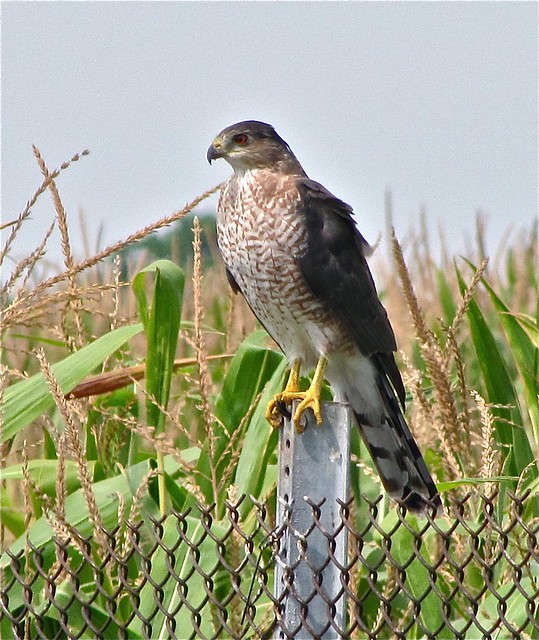
Other shorebirds present included the Solitary Sandpiper and Least Sandpiper below. There were a total of three Solitary Sandpipers and at least three Leasts. There were also another 17 peeps I could not positively identify. Finally, there were four Spotted Sandpipers and three Lesser Yellowlegs present.


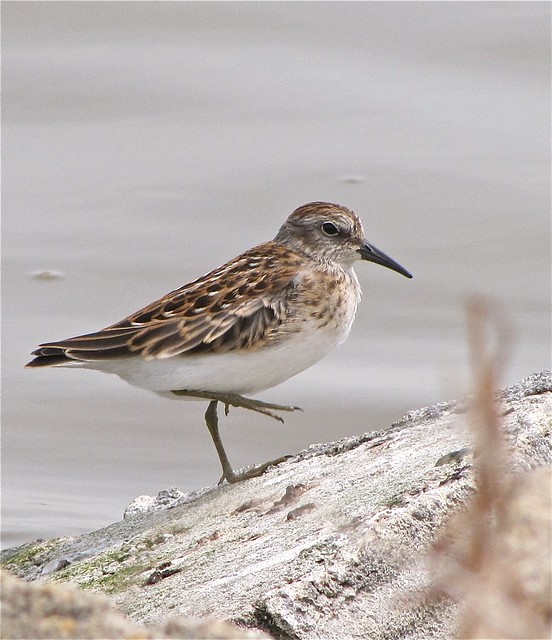
I returned to Gridley the next day, hoping to see the Buff-breasted Sandpipers again, but the first bird I photographed was this juvenile Cooper's Hawk, flying over the East pond.

Next, although I did not recognize it at the time, I photographed my lifer Baird's Sandpiper--one of two Baird's present.
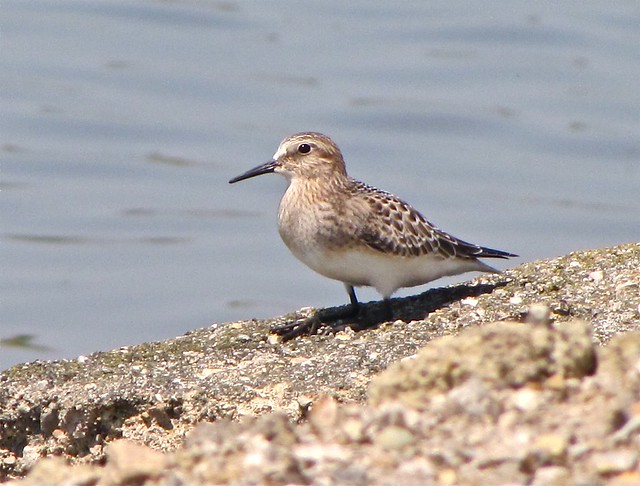
Also present were Semipalmated, Least, and Pectoral Sandpipers and not just four, but a total of six Buff-breasted Sandpipers. The Southwest pond was nearly empty with just a few puddles of water and the Buff-breasted Sandpipers were feeding in it with several other sandpipers and killdeer.
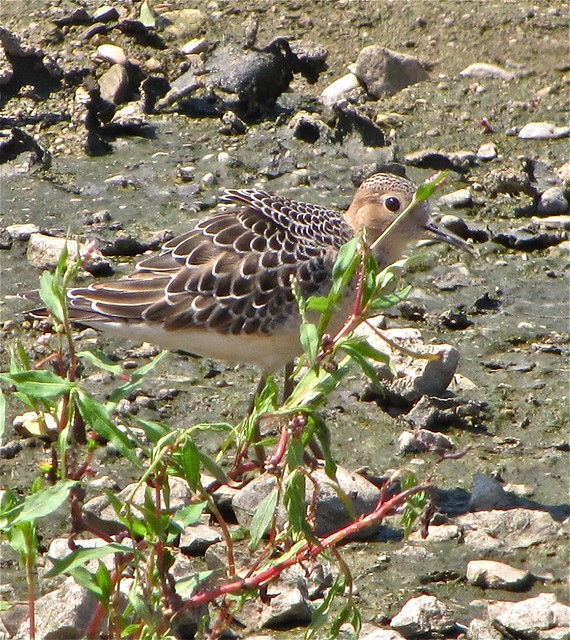


On September 1, Les Allen went back to Gridley with me to see the Buff-breasted Sandpipers. Les needed a Buff-breasted Sandpiper for his McLean County Big Year. When we first arrived at Gridley, a Cooper's Hawk chased all of the shorebirds out of the empty pond, and we had difficulty finding a Buff-breasted. I was starting to think they had moved on. Then we found one in the grass beside the East pond, and Les had his big year addition. By the time we got back around to the empty Southwest pond, the shorebirds, including the Buff-breasted we had just seen, had all returned, and there were a total of six Buff-breasted Sandpipers feeding on the little flat. Also present at some point during this visit was a Northern Harrier. We called Dale Birkenholz and invited him to come out to see the Buff-breasted Sandpipers. While we were waiting for him to come, we drove to El Paso to see if there were any different birds there. When we arrived at El Paso, we saw another Northern Harrier. Shorebirds present included Least and Semipalmated Sandpipers and what appeared to be the juvenile Sanderling I had recently seen there.
We drove back to Gridley in time to meet up with Dale Birkenholz. The Buff-breasted Sandpipers were still feeding in the Southwest lagoon with a variety of different shorebirds. We parked beside the empty Southwest pond and set up the scopes. Then we watched the Buff-breasted Sandpipers and the other birds on the little flat to our hearts' content. The light was great and we had a great view through the scope. Les said it was just like watching TV. The first photo below shows all six of the Buff-breasted Sandpipers.



We were also looking at the other shorebirds, hoping to find a Baird's Sandpiper. In this video Les and Dale are talking about a bird that they are looking at that is a candidate for Baird's, while I am still focused ont the Buff-breasted Sandpipers.
Les and Dale did later see a Baird's on the rocks, and this bird below, which I photographed on the pond flat that day was a Baird's. I'm not sure whether this was the same bird they were describing in the video above. Baird's is often confused with Semipalmated Sandpiper. Both are brown and white sandpipers with black legs, but the distinguishing characteristics of Baird's are a more heavily streaked head and chest, a scaly patterned back, and primary wing feathers which extend beyond the tail feathers of the bird. Each of these characteristics can be observed of the bird shown below. Baird's is also a little larger than Semipalmated and has a slightly longer and more curved bill, while the bill of a Semipalmated is relatively short and straight.
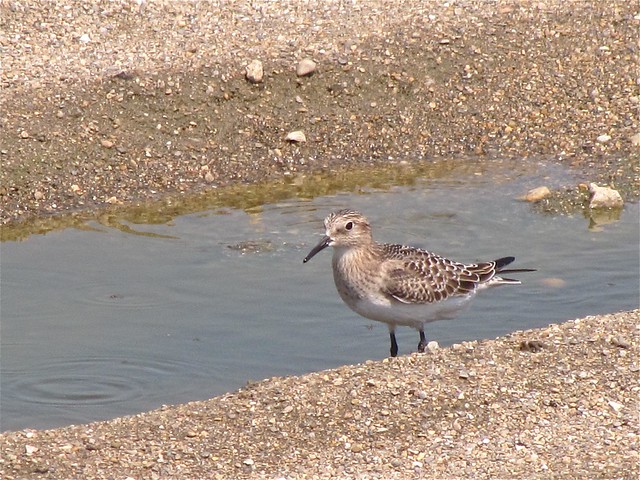
As we left the little flat and drove around the other ponds, I observed this Solitary Sandpiper eating an Eastern Amberwing dragonfly.
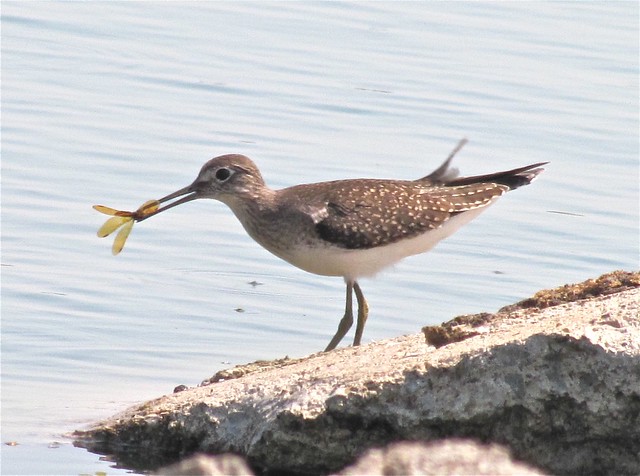
I also photographed a Least Sandpiper and a Semipalmated Sandpiper both shown below. At first I thought the Semipalmated was a Baird's, but the differences with the Baird's shown above are obvious--very little streaking on the chest, more white on the head, short primaries that do not extend beyond the tail feathers, and a short, straight bill.
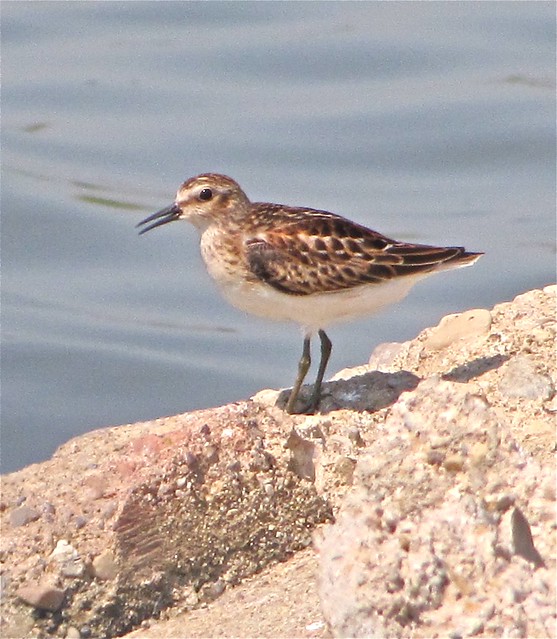
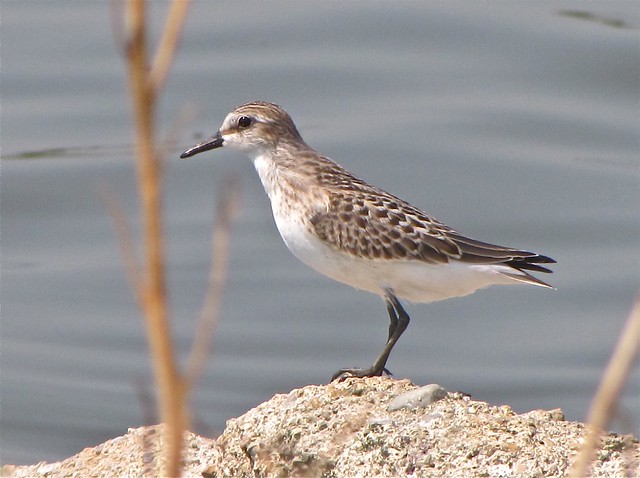
Below is a list of my shorebird totals at Gridley on September 1.
Killdeer 60
Spotted Sandpiper 4
Solitary Sandpiper 2
Lesser Yellowlegs 1
Semipalmated Sandpiper 5
Least Sandpiper 5
Baird's Sandpiper 1
Pectoral Sandpiper 3
peep sp. 20
Buff-breasted Sandpiper 6
The next day, September 2, I stopped by El Paso before my evening shift at work. The little Northwest pond had just a little water in it forming a nice flat. As I drove up to the flat, I pulled up behind Matt Fraker, who was already there watching the shorebirds from his SUV. I noticed several shorebirds on the flat, but I mistook the three Stilt Sandpipers for yellowlegs, and though I recognized about ten Leasts, I did not notice the Baird's Sandpiper. I did, however, take a few pictures of these birds without knowing what I was photographing.
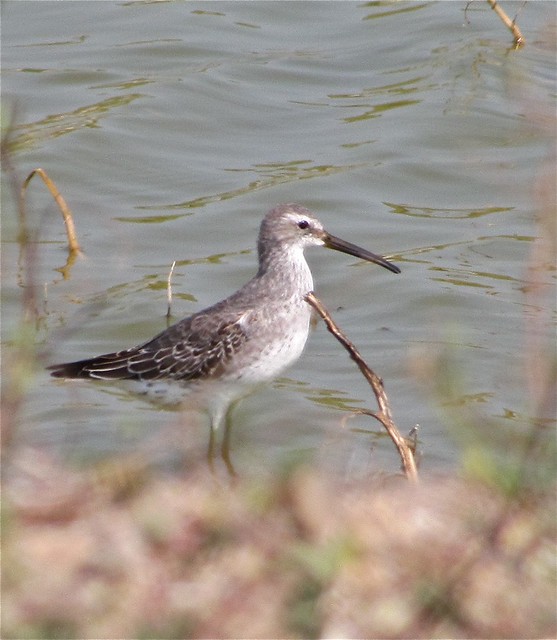
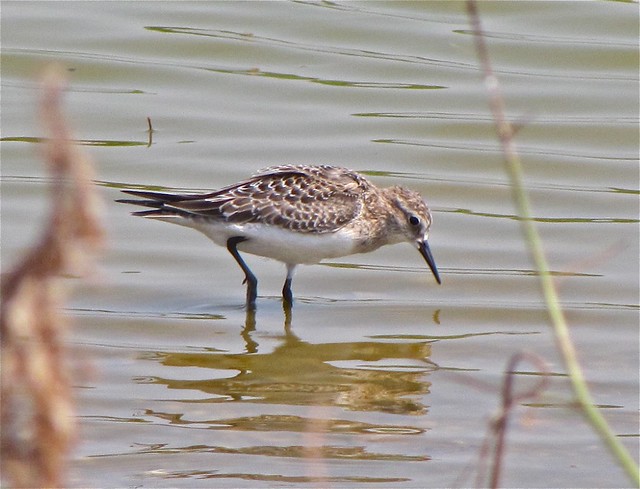

Not realizing what we had in front of us and eager to introduce myself to Matt, I stepped out of the car. Although I was trying not to flush the birds, the three Stilt Sandpipers flushed. After I shook Matt's hand and introduced myself, he asked if I had seen the Stilts and the Baird's, which was still there. Suddenly I realized my blunder. Matt seemed confident that the Stilt Sandpipers would return, and he was not upset that I had flushed them. Unfortunately, I had to go to work and did not have time to wait for them to return. I know that they returned after I left because Matt posted some great pictures of them on Illinois Birder's Forum.
The next day, September 3, I returned hoping to get longer looks at the Stilt and Baird's Sandpipers. Unfortunately the Stilt Sandpipers were gone, but two Baird's Sandpipers were still present. Below is one of the Baird's with three Pectoral Sandpipers. The Baird's is the bird in the bottom right corner.

Also present was this Greater Yellowlegs.

Although I wanted to get better pictures of the Baird's, I could not resist photographing these two Buff-breasted Sandpipers, which landed on the mudflat. The lower bird had some strange scarring on its face.
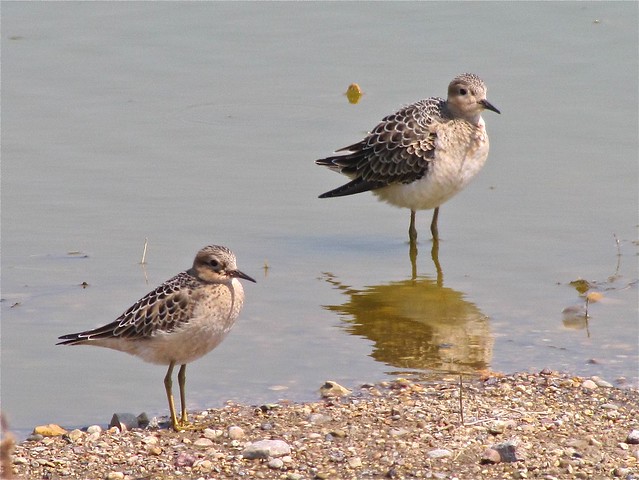

After photographing the Buff-breasted Sandpipers, I returned to the Baird's. Click on either of he first two photos below to see more of the Baird's.


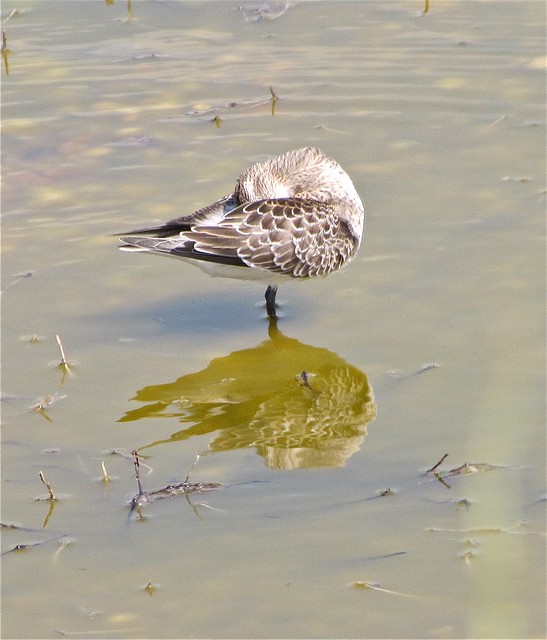
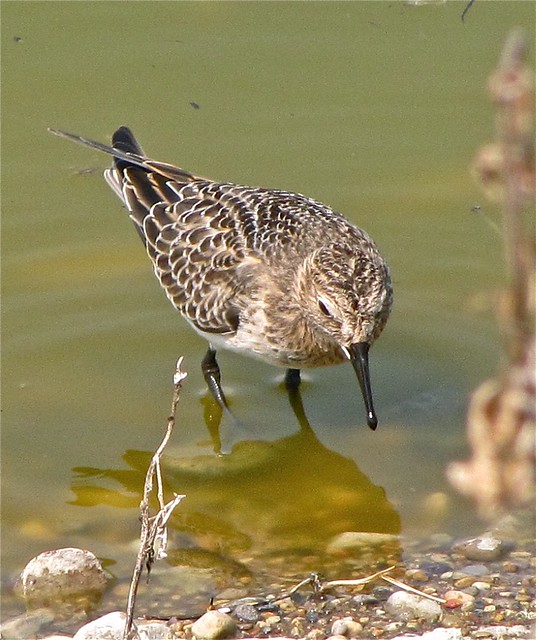
There were also several Least Sandpipers feeding with the two Baird's Sandpipers. Below is a photo of a Least Sandpiper that was present and one showing a Baird's and a Least Sandpiper feeding together.


Killdeers were present in usual large numbers. The shorebird totals for September 3 at El Paso are shown below.
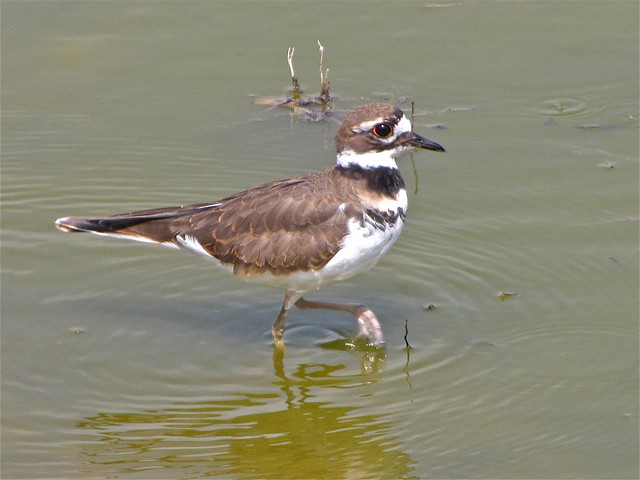
Killdeer 60
Spotted Sandpiper 3
Greater Yellowlegs 1
Semipalmated Sandpiper 2
Least Sandpiper 5
Baird's Sandpiper 2
Pectoral Sandpiper 5
Buff-breasted Sandpiper 3
On September 4, the only shorebirds present were the American Golden-plover and Baird's Sandpiper shown below, four Least Sandpipers, one Buff-breasted Sandpiper, and about 30 Killdeer. On the way out I ran into Matthew Winks checking out the 100 Blue-winged Teal and 11 shovelers with his scope. Also present were 20 Canada Geese, two Wood Ducks, and one Pied-billed Grebe.
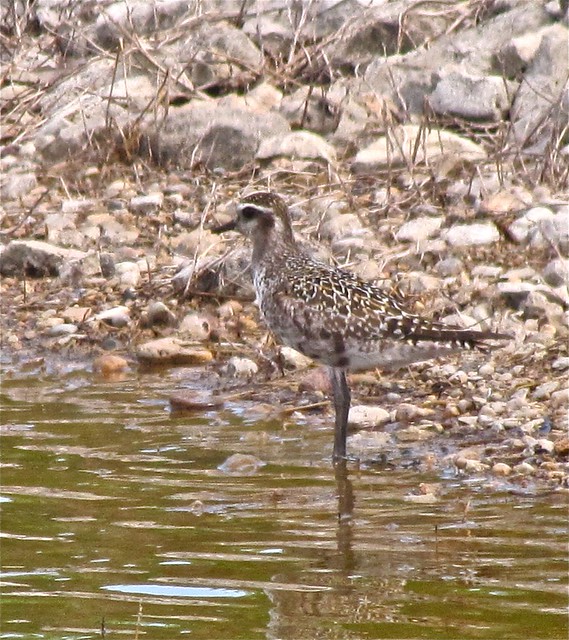
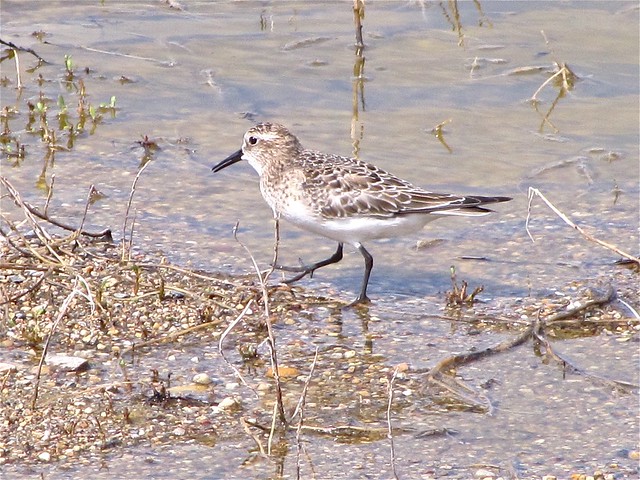
I returned to El Paso two days later on September 6 after work, finding two Least Sandpipers, two Solitary Sandpipers, and a Pectoral Sandpiper, but the highlight of my visit was this Black-bellied Plover, also shown at the beginning of this post--another lifer for me.
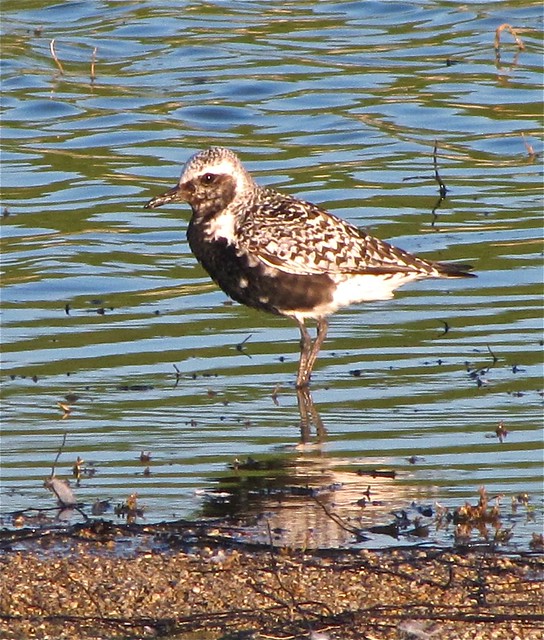
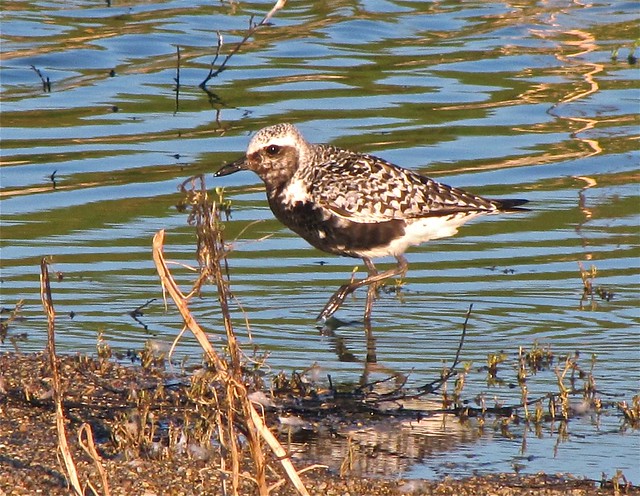
Here is the Pectoral with one of the Solitaries. Notice the difference between the yellow legs of the Pectoral on the left and the the greenish legs of the Solitary on the right. Also below are a couple more shots of the Solitary and one of the Pectoral. Click on the second Solitary photo to see more of the Solitary.

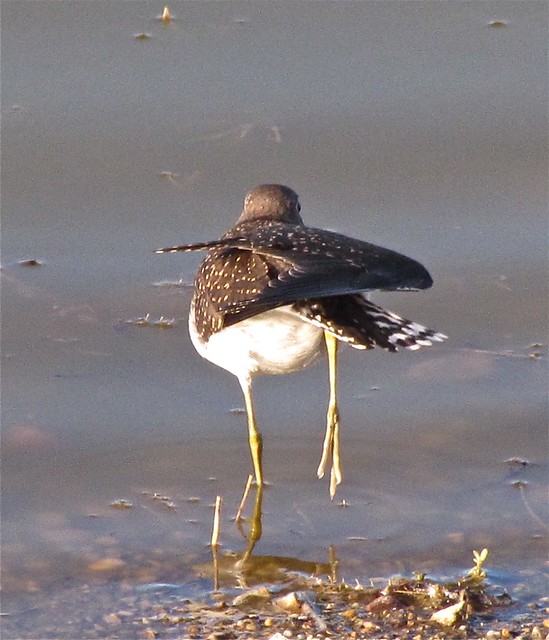
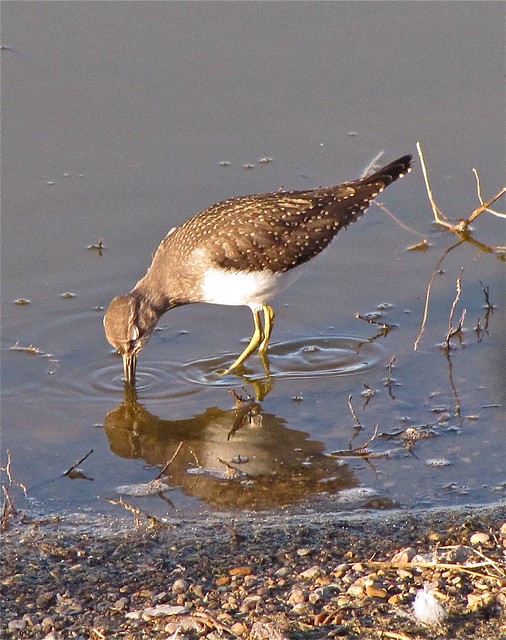
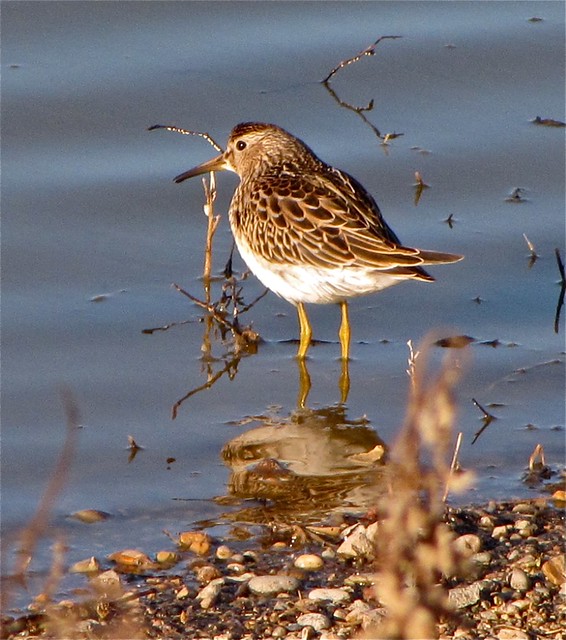
Another interesting find that day was a Killdeer with a broken wing. Often Killdeer will fake broken wings to lead you away from their nests. This one was not faking.
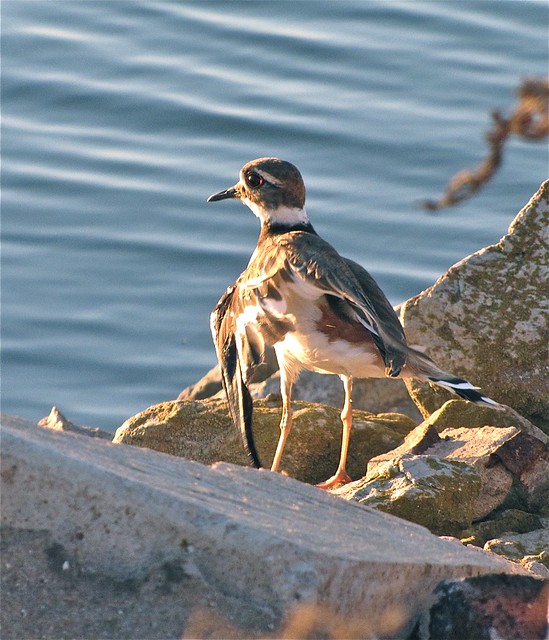
After work the next day, I returned to El Paso and found my first Woodford County Short-billed Dowitcher.

The Black-bellied Plover was still present, but was in the grass around the Northeast pond this time.
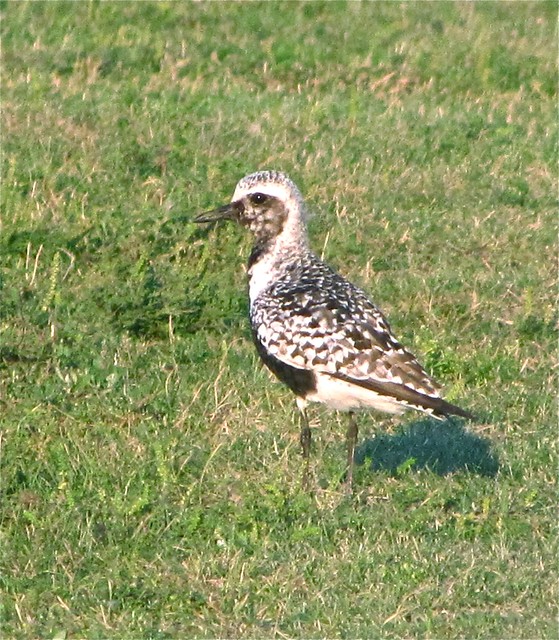
My total shorebird counts for September 7 are shown below.
Black-bellied Plover 1
Killdeer X
Spotted Sandpiper 2
Solitary Sandpiper 3
Semipalmated Sandpiper 11
Least Sandpiper 3
Baird's Sandpiper 1
Pectoral Sandpiper 1
Short-billed Dowitcher 1
On September 8, I saw this Lesser Yellowlegs and Least Sandpiper at Gridley.
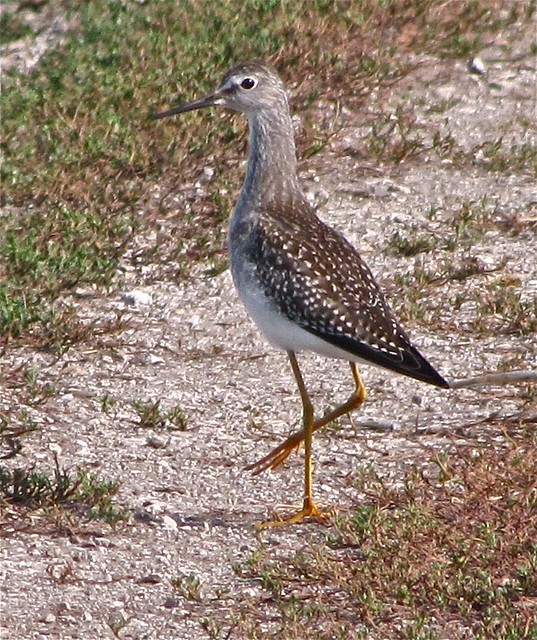

I also stopped by El Paso the same day and observed two Black-bellied Plovers, a Semipalmated Sandpiper, a Baird's Sandpiper, and two Least Sandpipers.
On September 10, the empty pond mudflat at El Paso held three Baird's Sandpipers. As I was photographing them, Dan Williams drove up behind to look at all the shorebirds on the little flat. When we spoke a little later, he pointed out that a couple of these Baird's including the one shown below were juveniles. I had noticed that they looked different than the adult Baird's present. At first I had thought they might be Sanderlings.
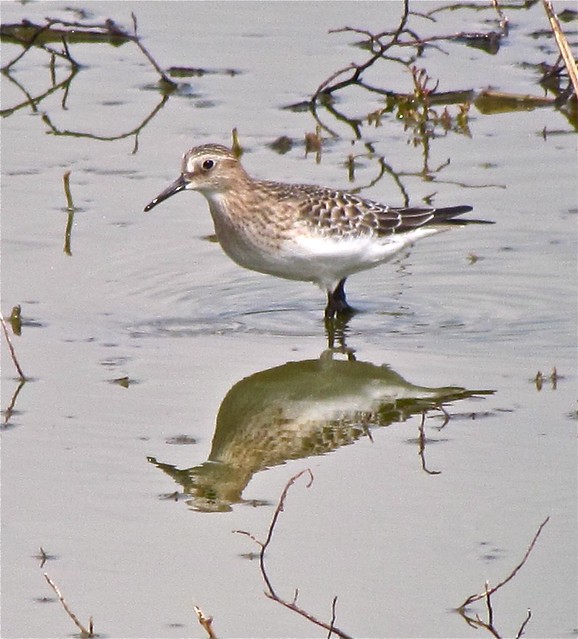
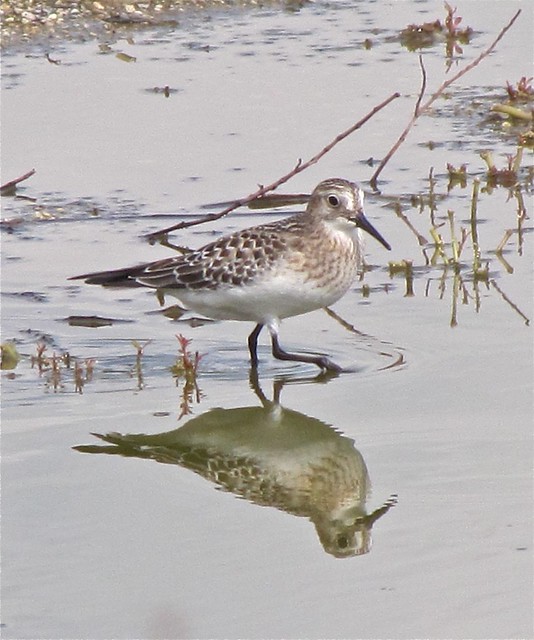
I also photographed this White-rumped Sandpiper without knowing what it was. At the time, I mistook it for one of the Baird's Sandpipers. When Dan Williams later told me that there was a White-rumped Sandpiper on the flat, I thought I had missed it. I did not recognize that I had already photographed this bird until a couple of days later.
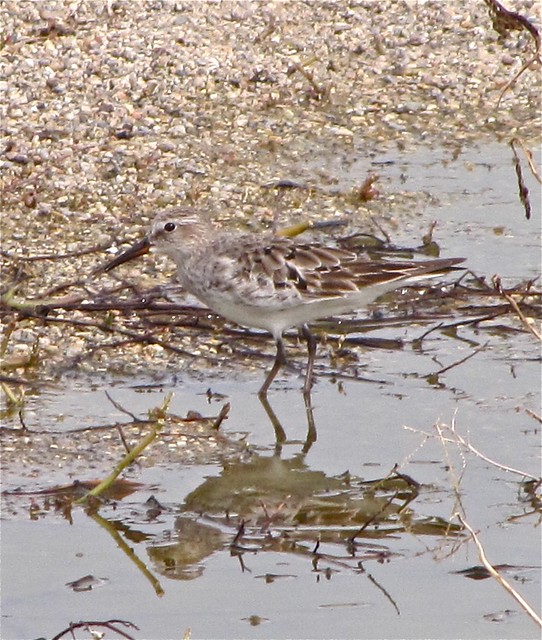
With Dan behind me, I drove on around to the next pond so that he could get a better look at the shorebirds on the flat. This adult Baird's was on the rocks beside the Northeast pond.

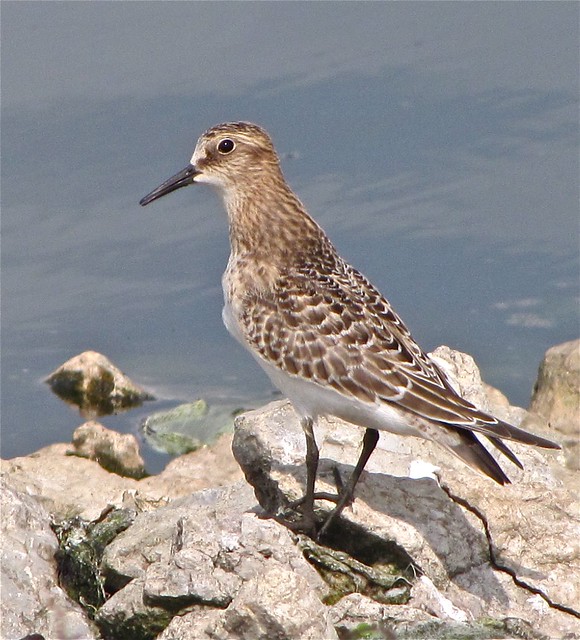
I also noticed this Black-bellied Plover on the rocks by the pond.
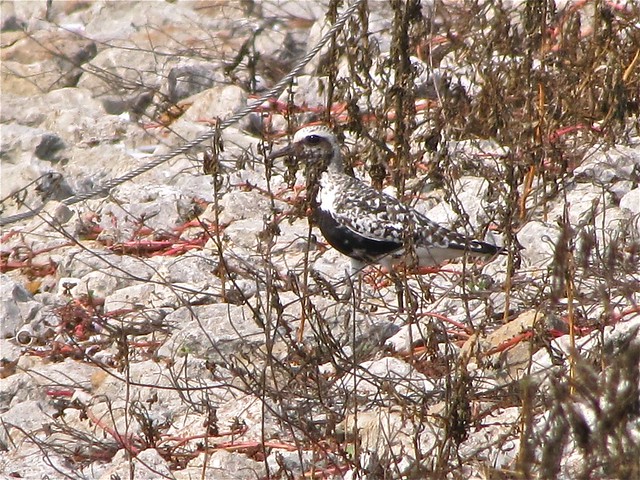
As I continued driving around the pond, I saw another Black-bellied Plover with different plumage. Dan followed behind me to get a look at these birds as well.

Dan and I introduced ourselves to each other before I left.. Dan was going to let me look through his scope at the White-rumped Sandpiper, but I had to leave to go to work. It was nice to meet Dan and to share this birding experience with him. Below is a complete list of the birds I counted at El Paso on September 10.
Black-bellied Plover 2
Killdeer 60
Solitary Sandpiper 1
Semipalmated Sandpiper 2
Least Sandpiper 3
White-rumped Sandpiper 1
Baird's Sandpiper 4
Pectoral Sandpiper 1
The next day, on 9/11, I returned, thinking I had missed the White-rumped Sandpiper, hoping to see and photograph it. I was not disappointed. Not only did I see the White-rumped. I also saw my lifer Semipalmated Plover. Here are a couple of shots of the White-rumped. Notice the red mark at the bottom of the base of the bill and the dark feathers on the wings. Both characteristics distinguish White-rumped from other peeps.
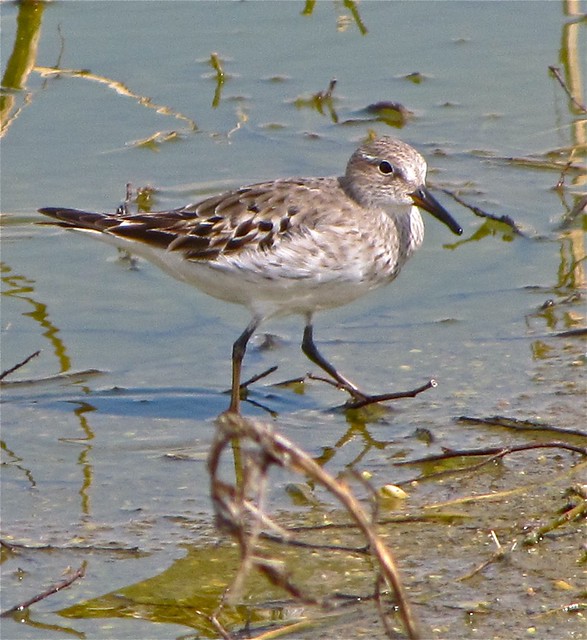


Here is the Semipalmated Plover. Notice that it looks almost exactly like a Killdeer, but it is much smaller and has only one ring around it's neck instead of two. The Killdeer on the flat chased this little guy away several times when it was feeding too close to them. Also, notice that the feet on this bird are slightly webbed at the top of the toes. Thus the bird gets its name--Semipalmated. Click on this first picture and scroll down to see a couple more shots.

Here the bird seems to be using the feeding technique of foot-trembling, lightly touching the water or mud to expose prey beneath the surface.
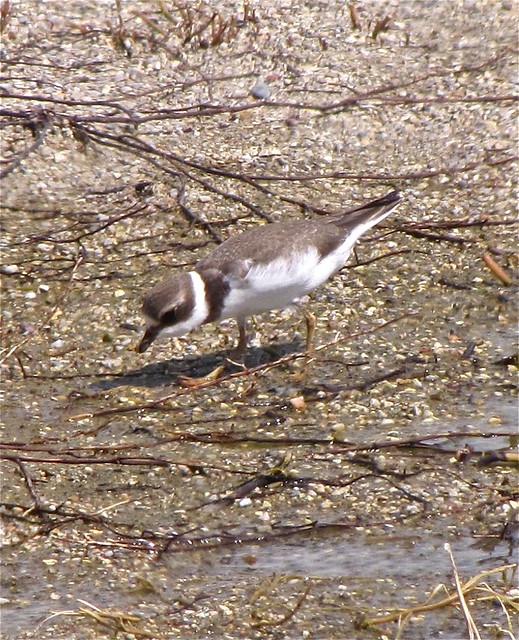
I had often observed Killdeer feigning a broken wing, but I did not know a Semipalmated Plover would do the same thing. This certainly appeared to be what this little guy was doing.
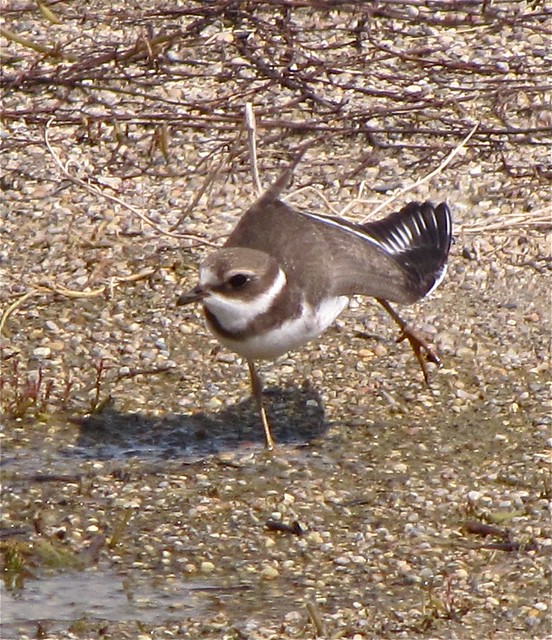
Another bird present and giving glorious looks was this Semipalmated Sandpiper. I struggled with the identity of this bird because of the rufous on its wings, which made me think it might be a Western Sandpiper. However, the short, straight bill seems to indicate Semipalmated.
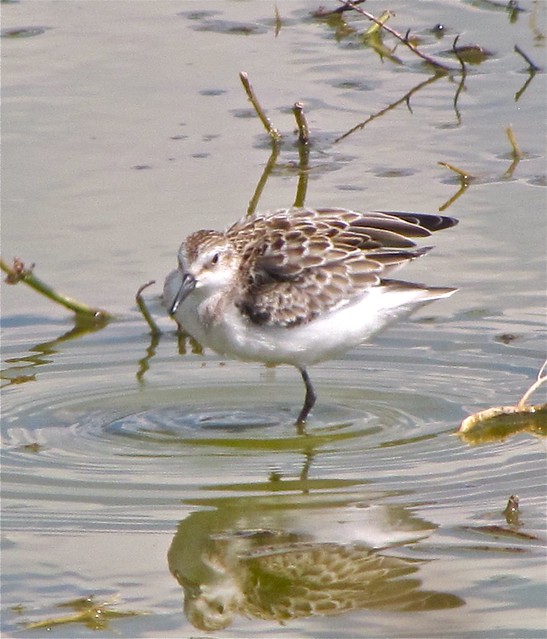
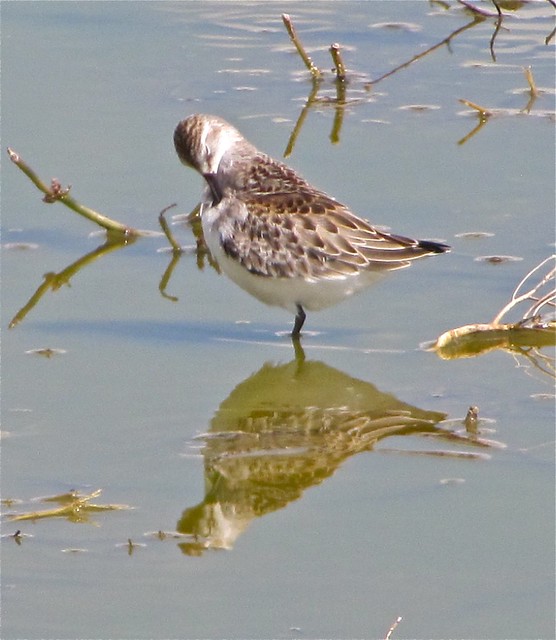

As I mentioned above, another bird often confused with Semipalmated Sandpiper is Baird's Sandpiper. Here is a shot I took of both of them together for comparison. Notice the Baird's is larger, has more streaking on the face and chest, and has longer feathers on its wings, which extend beyond its tail feathers.
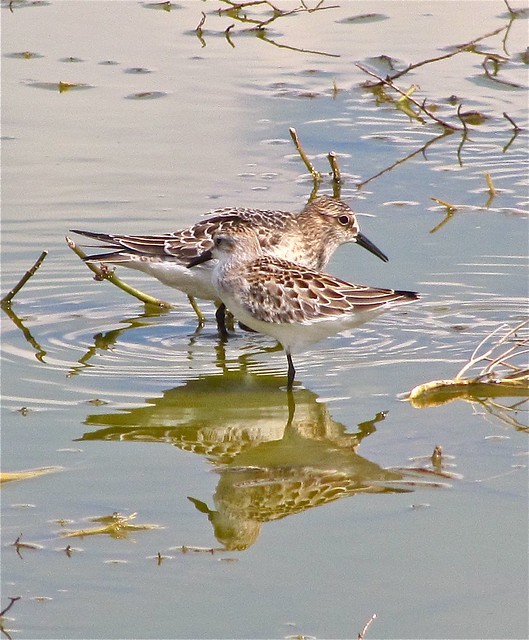
And here is a shot of the Semipalmated Sandpiper with the White-rumped.

Before I left, this juvenile Red-tailed Hawk flew over the South pond of the facility.
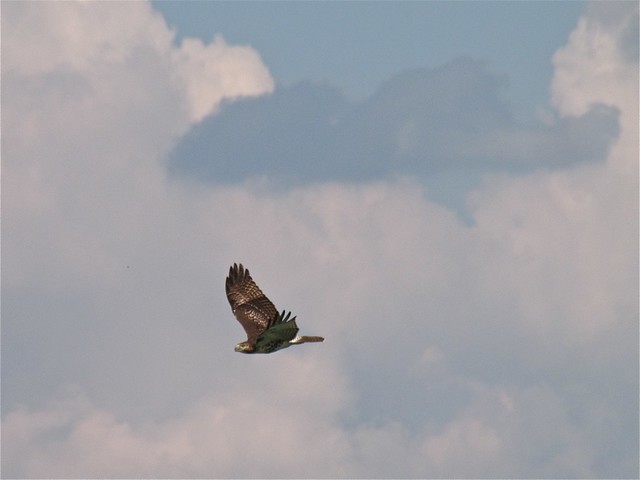
Here are my shorebird totals for El Paso for 9/11. The Black-bellied Plovers were no longer present.
Semipalmated Plover 1
Killdeer 60
Solitary Sandpiper 1
Semipalmated Sandpiper 7
Least Sandpiper 3
White-rumped Sandpiper 1
Baird's Sandpiper 4
Pectoral Sandpiper 1
By September 13, the flat was dry and most of the shorebirds were gone, but I did come across this lonely Solitary Sandpiper.

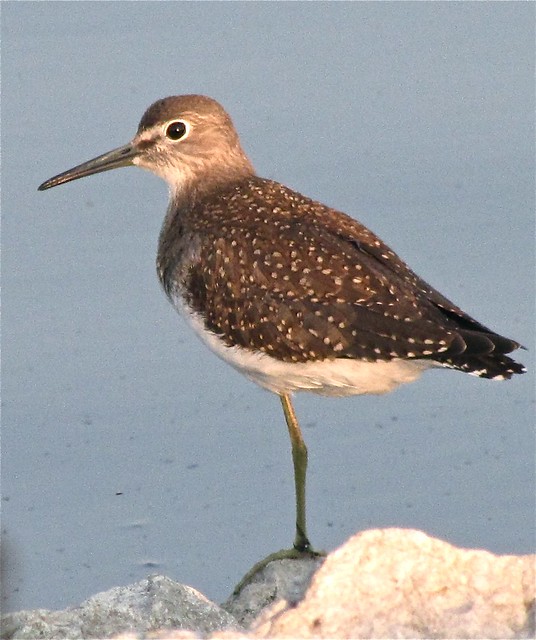
Then I had a few interesting shorebirds at Gridley on September 20--one Spotted Sandpiper, one Lesser Yellowlegs, one Pectoral Sandpiper, and one Buff-breasted Sandpiper. Here is the Buff-breasted . . .
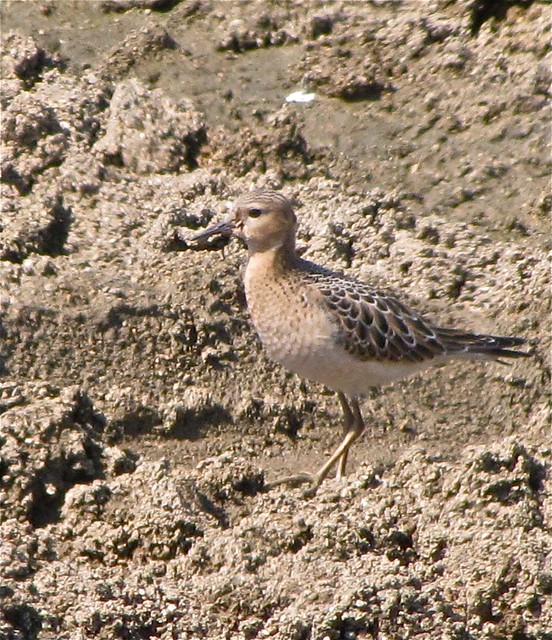
Here is the Lesser Yellowlegs . . .

And here is the Pectoral . . .
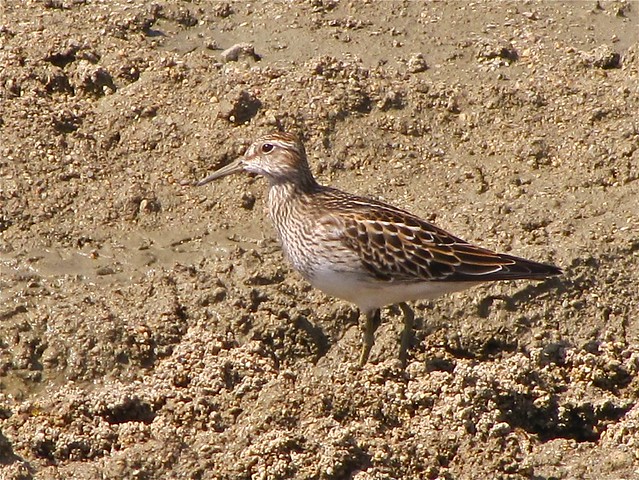
My visit to El Paso the same day only yielded this shot of a Great Blue Heron.
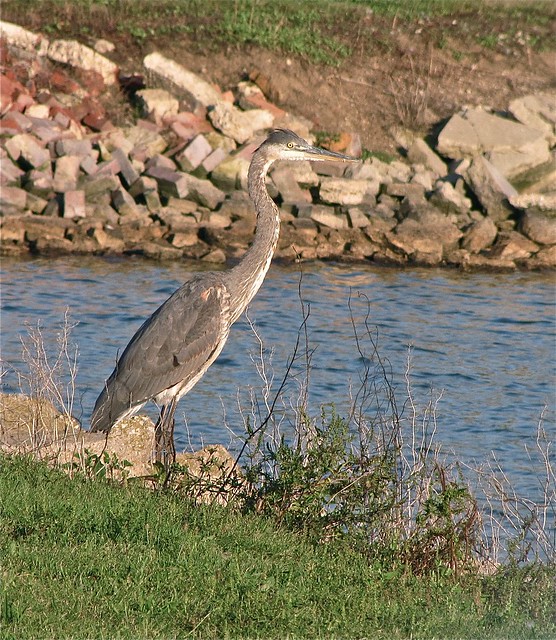
On September 23, the lack of shorebirds at Gridley did not stop me from photographing this Pied-billed Grebe and these American Pipits. The American Pipit sometimes looks to me like a miniature Buff-breasted Sandpiper. This bird was actually once named the Buff-bellied Pipit.
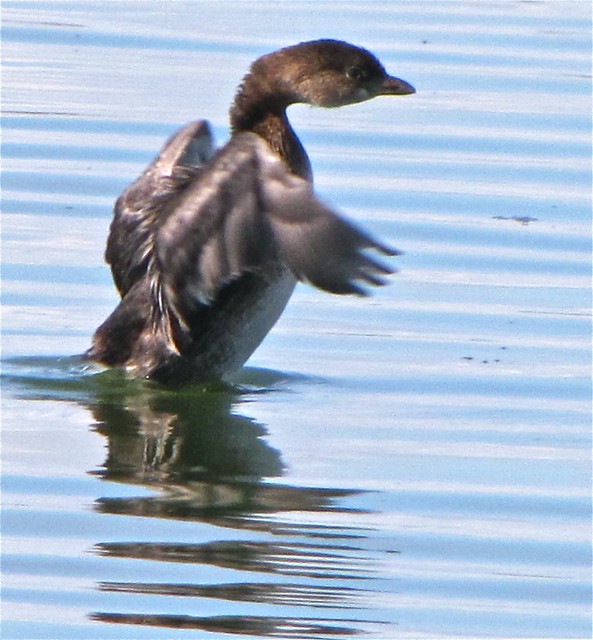
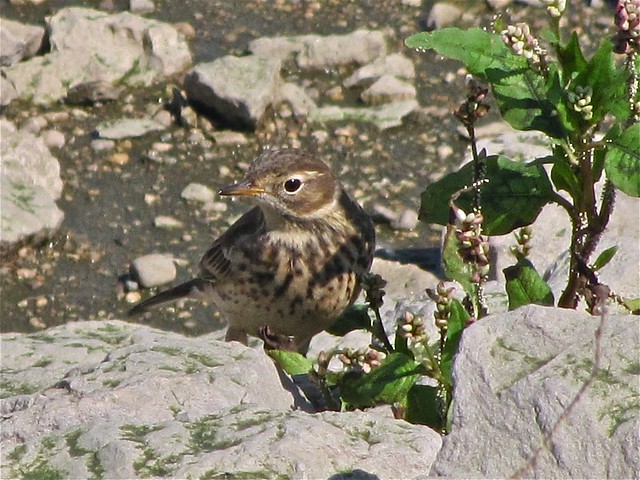
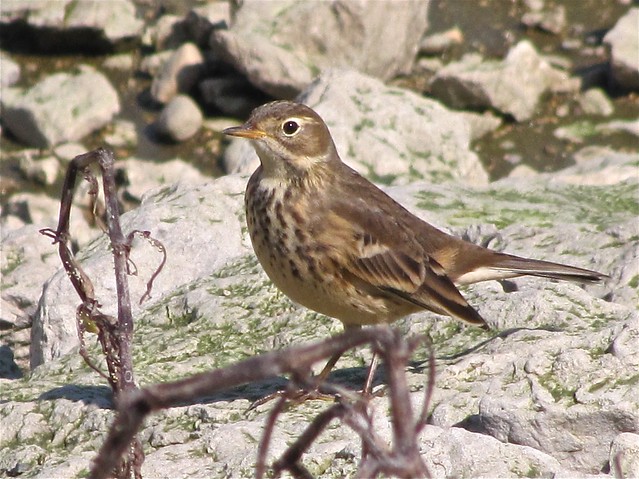
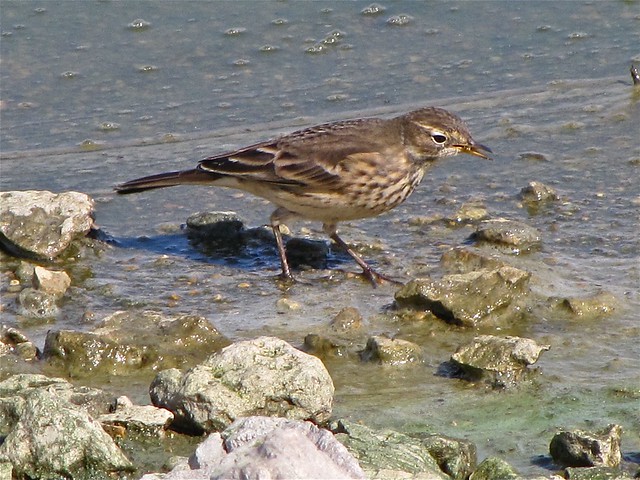
After birding at Gridley, I stopped by El Paso and saw a funny looking Killdeer. As I got closer to it, I realized that it only had one wing. The other had been completely ripped off. Not wanting it to suffer, I captured it and called Matt Fraker, who is a veterinarian. Matt asked me to drive it over to his house in Bloomington after which he tried to save it, while allowing it to take up residence in his bath tub. Unfortunately, after the wound seemed to be healing, it barely bumped the wall of the tub and reopened the wound, thus the poor creature did not make it. Matt had to put it down.
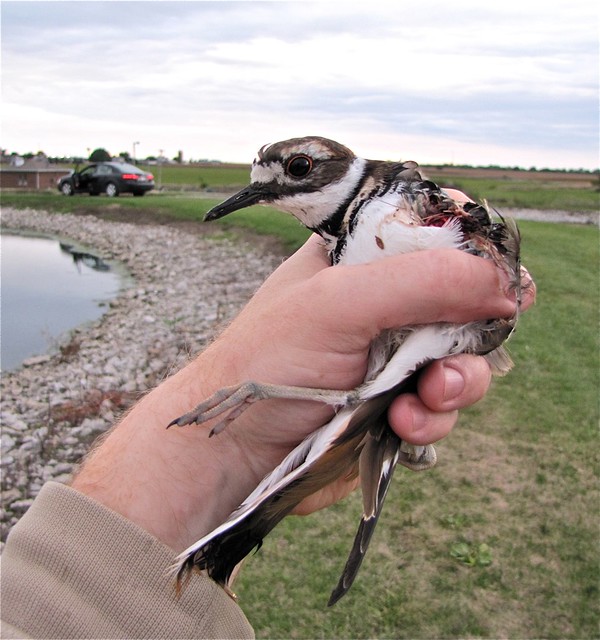
On September 30, I had a couple of nice Pecs and a Least at El Paso. The Least seemed to be molting into its basic plumage. Click on either of the last two pics and scroll down to see more shots of these birds.

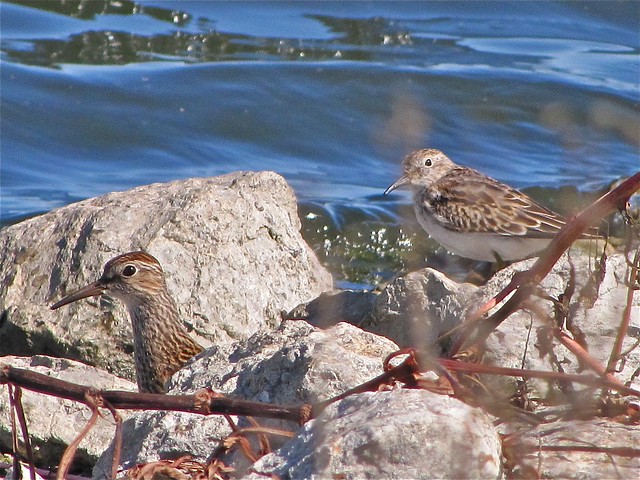


October 10 was a pretty good day for shorebirds at Gridley. My favorite of the day was this Wilson's Snipe, which did not flush for several minutes though I was a few feet away in my car, while driving around the middle pond.
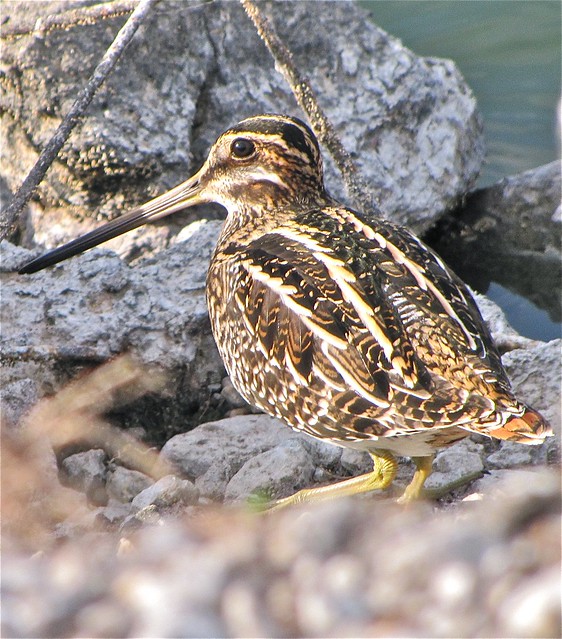
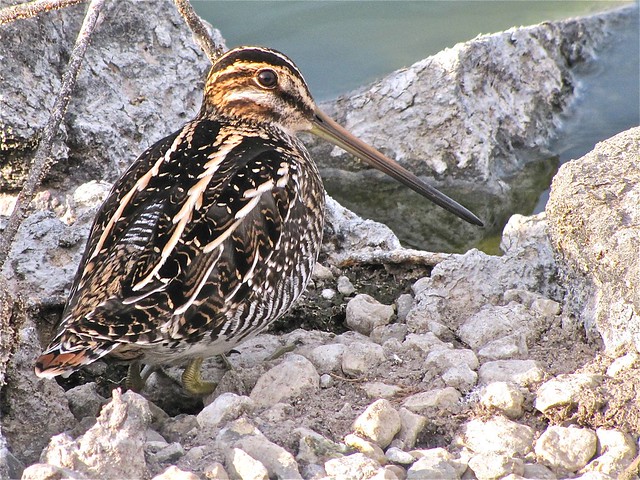
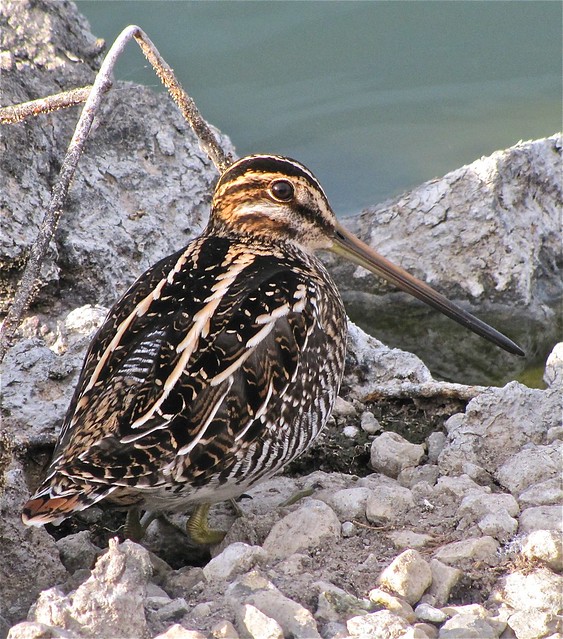
Also present were two Leasts, a Pec, a Buff-breasted, a Spotted, and two other snipes that flushed. The Spotted, Buff-breasted, and the Pec were all still present on October 12, and the Buff-breasted and the Spotted were still around on the 13th. Surprisingly, the Spotted was still present almost a month later on November 11. It seemed injured because it was flying low and its feathers seemed disheveled.
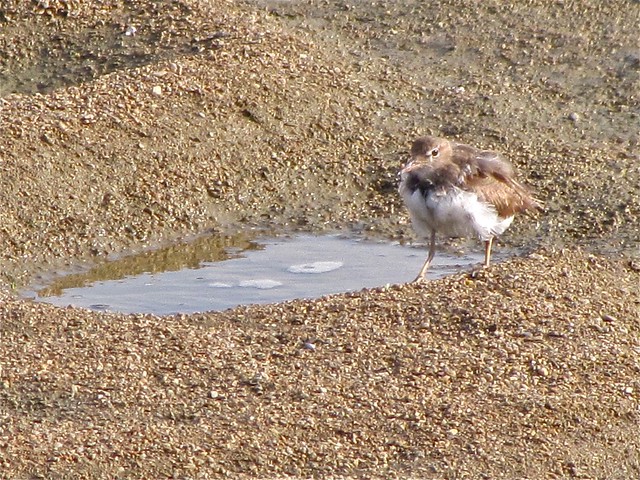
On October 11, there was a flock of at least 13 American Golden-plover at El Paso.

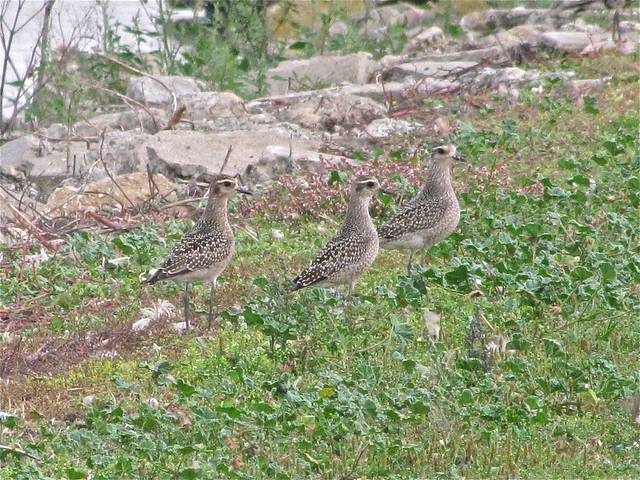
Then on November 8, I saw about twenty Lesser Yellowlegs and four Greater Yellowlegs at El Paso. A couple of Lesser Yellowlegs were still around on the 10th. After that at the sewage ponds, it was mostly just sparrows, ducks, and geese, which I had already seen a fair amount of though I did not include most of those sightings in this report.
Shorebirding in McLean County, however, was not quite over. Evergreen Lake finally dried up enough to form a mudflat or two, which actually drew in a few shorebirds, including a couple of Stilt Sandpipers, a Black-bellied Plover, and a Long-billed Dowitcher, but if it had not been for the sewage ponds in Gridley and El Paso, I would have seen precious few shorebirds this past Fall.
Below is a list of all the shorebirds I saw in 2011 at Gridley Wastewater Treatment Ponds with the dates I first observed each species at this location.
1. American Golden-Plover - 10 May 2011
2. Killdeer - 14 Mar 2011
3. Spotted Sandpiper - 10 May 2011
4. Solitary Sandpiper - 26 Jul 2011
5. Greater Yellowlegs - 11 Jul 2011
6. Lesser Yellowlegs - 28 Aug 2011
7. Semipalmated Sandpiper - 28 Aug 2011
8. Least Sandpiper - 11 Jul 2011
9. Baird's Sandpiper - 31 Aug 2011
10. Pectoral Sandpiper - 10 May 2011
11. Buff-breasted Sandpiper - 30 Aug 2011
12. Short-billed Dowitcher - 25 Jul 2011
13. Wilson's Snipe - 10 Oct 2011
And here is a list of all the shorebirds I saw in 2011 at El Paso Sewage Treatment Center with the corresponding dates. Also, although I missed them, American Avocets were observed this Summer by Ted Hartzler and Matt Fraker at El Paso.
1. Black-bellied Plover - 06 Sep 2011
2. American Golden-Plover - 04 Sep 2011
3. Semipalmated Plover - 11 Sep 2011
4. Killdeer - 17 Jul 2011
5. Spotted Sandpiper - 29 Jul 2011
6. Solitary Sandpiper - 30 Jul 2011
7. Greater Yellowlegs - 18 Apr 2011
8. Lesser Yellowlegs - 29 Jul 2011
9. Sanderling - 29 Aug 2011
10. Semipalmated Sandpiper - 29 Aug 2011
11. Least Sandpiper - 17 Jul 2011
12. White-rumped Sandpiper - 10 Sep 2011
13. Baird's Sandpiper - 02 Sep 2011
14. Pectoral Sandpiper - 03 Sep 2011
15. Stilt Sandpiper - 02 Sep 2011
16. Buff-breasted Sandpiper - 03 Sep 2011
17. Short-billed Dowitcher - 07 Sep 2011
18. Wilson's Snipe - ?
Obviously, I observed a larger variety of shorebirds at El Paso. Although the ponds at El Paso are larger and may, therefore, attract a larger variety of species, I also think it is possible that I may have missed some of the species that were present at Gridley for two reasons. First, I did not have a scope at the time and, therefore, saw many shorebirds that I could not identify at Gridley, while at times the layout at El Paso made it easier there to get close enough to identify the birds without flushing them. Second, the Gridley ponds are less accessible because they are locked most evenings and weekends and often when there is rain. There were many times that I wanted to bird the ponds in Gridley but could not because the gates were locked. I may have missed several species for this reason alone.
Written and published on January 7, 2012
I really enjoy your blog.
ReplyDeleteThanks JC!
ReplyDelete